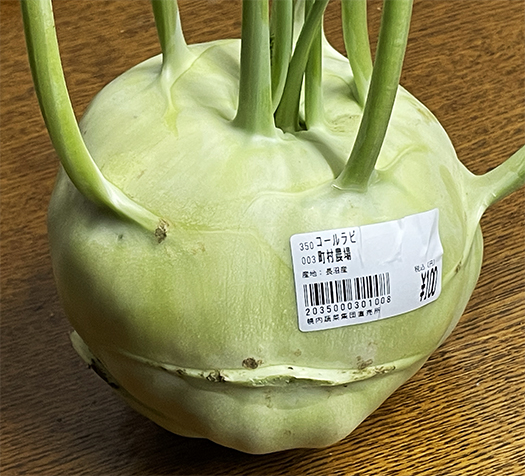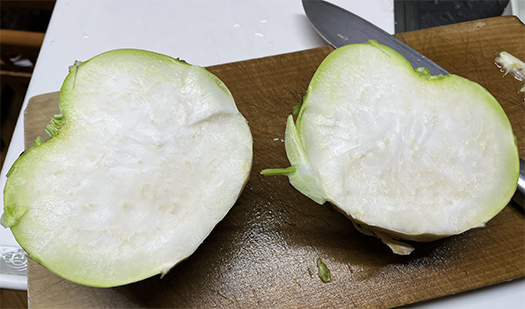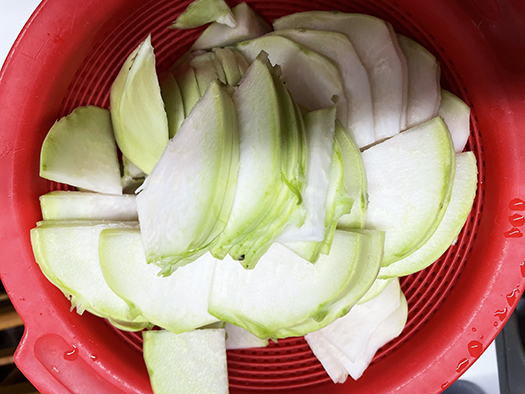
札幌の近郊、長沼には国道沿いに広大な駐車スペースをそなえた農産物市場があります。ときどき手軽な行楽として季節の野菜類を探すことが習慣化しています。
きのう、ちょっと朝寝坊したので長距離移動を避けて、こちらに向かった。行ってみたら各店舗棟が建て替えられていて、リニューアルしていた。わたしの実家、父親は入植した祖父から受け継いだ畑で「まるで野菜類の品評会だ」といわれるほど多種多様な野菜生産に取り組んでいた。そこでいろいろ実験して成果の得られた野菜類をほかの農家に伝え製法の勘所などを教えて、多量生産にして、その生産物を遠く大阪の市場に出荷して北海道野菜の販路拡大に取り組んでいた。そういうなかで「ユリ根」は大当たりしたと聞いている。
その生産にあたっては当時のもっとも先端的農業者だった岐阜県からの移住者一家で育った母親が、その生産技術で取り組んでいた。わかい夫婦が手を取り合って新品種開拓に取り組んでいたのだというのですね。3歳までしか農家にいなかったわたしとしてはすべてが伝聞。
だけれど、こういう農産物市場に来ると、無意識でそういう新品種に目が行く。はるかな父母のことをそういうカタチで「探している」のかも知れません。
そんな目に飛び込んできたのが写真の「コールラビ」。〜アブラナ科の越年草。原産地は地中海北部。球状に肥大した茎部を、皮をむいて食用とする野菜である。茎は緑色系と紫色系があり、キャベツやブロッコリーの茎に似た味で、サラダやピクルスなどにする。語源はドイツ語で、キャベツを指すkohlとカブを指すrabiより。〜


値段を見るとなんと「100円」。買ったときにはその素性詳細はわからなかったのだけれど、内面から「騒ぐ血」を感じて即座に購入(笑)。市場の売り場でもカンタンに説明があった通り、浅漬けにしてみた次第です。
ということで頃やよし、ということでさっそく食してみた。軽く塩を振って「浅漬けのもと」を加えて厚手のビニールパックに入れ、なおコンブを小さく切って混ぜ合わせて加圧しまくる。で、放置して数時間。口に入れてみた。
まぁライトな「カブ」か。カブ大根よりもちょっと「キャベツ」っぽい味わいがあって、カブよりも皮が厚くてごつい。「あ、こりゃぁ皮は剥いた方が無難かな」というところですが、切り方を薄くしたヤツだと、それなりの柔らかさは出てくる。まぁワルくはないといった一品でありました。
店頭ではこれ一個だけの出品だった(売り切れ寸前だった?)ので、まだ実験的段階なのでしょう。さて日本人の味覚ワールドに参入できるかどうか、でありますね。でも姿はカワイイ。
English version⬇
Discovering New Vegetables, Exploring Produce Markets
I have a strong desire to pioneer new vegetables from my parents’ farming days, and my eyes tend to swim at the market. What is the reaction of the Japanese market to the “in-between cabbage and daikon” variety? …
In Naganuma, a suburb of Sapporo, there is a produce market with a large parking lot along the national highway. It has become a habit for me to look for seasonal vegetables as an occasional easy outing.
Yesterday, I overslept a bit so I headed here to avoid a long-distance trip. When I got there, I found that each store building had been reconstructed and renovated. In my family, my father was engaged in the production of a wide variety of vegetables in the fields inherited from my grandfather, who settled in the area, to the extent that it was said, “It’s like a vegetable fair. He experimented with a variety of vegetables and taught other farmers the secrets of their production methods, which led to mass production and the shipment of their products to markets as far away as Osaka, thereby expanding the sales channels for Hokkaido vegetables. The “lily bulb” was a big hit among such efforts.
The mother, who grew up in a family of immigrants from Gifu Prefecture, the most advanced agricultural community of the time, was the one who used the most advanced production techniques. As I was only a farmer until I was three years old, this is all hearsay to me.
However, when I come to a farmers’ market like this, I unconsciously pay attention to such new varieties. It may be that I am “looking for” my parents in that way.
The one that caught my eye was the “kohlrabi” in the photo. 〜Kohlrabi is a perennial herb of the Brassicaceae family. It originates from the northern Mediterranean. It is a vegetable whose globularly enlarged stems are peeled and used for food. The stems are green or purple in color and taste similar to cabbage or broccoli stems, and are used in salads and pickles. The word is derived from the German words kohl for cabbage and rabi for turnip. ~ (from the German kohl, meaning cabbage, and rabi, meaning turnip)
When I looked at the price, I saw that it was 100 yen. When I bought it, I didn’t know the details of its identity, but I felt its “noisy blood” inside and bought it immediately (laugh). I tried to make asazuke (pickled in soy sauce), just as the explanation at the market had explained.
So it was about time, and I tried it right away. I lightly sprinkled salt, added “Asazuke no Moto” and put it in a thick plastic pack, cut kelp into small pieces, mixed them together, and pressurized it. And left it for a few hours. I put it in my mouth.
It was a light “daikon”. It tasted a little more like cabbage than daikon, and the skin was thicker and tougher than daikon. It was a bit like “Oh, it would be safer to peel the skin off,” but if you cut it thinner, it would have a certain softness to it. It was not bad at all.
This was the only one of its kind on display at the store (or was it on the verge of being sold out?), so it is still in the experimental stage. So, it is probably still in the experimental stage. Now, it remains to be seen if it will be able to enter the world of the Japanese taste buds. But it looks cute.
Posted on 8月 15th, 2024 by 三木 奎吾
Filed under: おとこの料理&食







コメントを投稿
「※誹謗中傷や、悪意のある書き込み、営利目的などのコメントを防ぐために、投稿された全てのコメントは一時的に保留されますのでご了承ください。」
You must be logged in to post a comment.